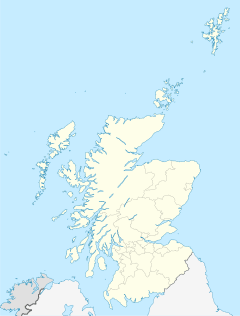Anderston facts for kids
Quick facts for kids Anderston
|
|
|---|---|
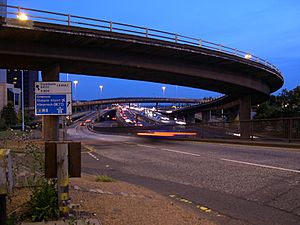 The M8 motorway at Anderston |
|
| OS grid reference | NS581660 |
| Council area | |
| Lieutenancy area |
|
| Country | Scotland |
| Sovereign state | United Kingdom |
| Post town | GLASGOW |
| Postcode district | G2, G3 |
| Dialling code | 0141 |
| Ambulance | Scottish |
| EU Parliament | Scotland |
| UK Parliament |
|
| Scottish Parliament | |
Anderston (Scots: Anderstoun, Scottish Gaelic: Baile Aindrea) is an area in Glasgow, Scotland. It is located on the north side of the River Clyde. This area forms the southwestern part of the city centre. Anderston started as a small village where people wove cloth in the early 1700s. It was an independent town from 1824 until 1846. Then, it became part of the larger City of Glasgow.
You can reach Anderston by train. The area has its own train stop called Anderston railway station.
Contents
How Anderston Began
The land where Anderston is today was once called the Bishop's Forest. This land was given to the Bishop of Glasgow by King James II in 1450. A family named Anderson owned part of this area, called Stobcross, from the mid-1500s. They built a large house there called Stobcross House. People say the name Stobcross came from a wooden cross, or 'stob', that marked the spot. Stobcross House was taken down in 1875 to build Queen’s Dock.
Anderston started as a less useful part of the Stobcross Estate. In 1725, James Anderson, who owned Stobcross House, rented out land for weavers to build cottages. The village was named Anderson Town after him, which later became Anderston. The first part of Anderston was near Gushet Farm. This spot is now Anderston Cross, where the Kingston Bridge carries the M8 motorway over the River Clyde.
In 1735, John Orr took over ownership of the village. Back then, Anderston had areas near the river for bleaching cloth. Main Street was lined with weavers' cottages. As trade grew, Anderston also grew in size. Another nearby village, Finnieston, was started in 1768 by Matthew Orr. It was named after Rev. John Finnie, who taught the Orr family. Weavers from Finnieston could join Anderston's weavers' group from 1774.
Anderston began as a village for weavers. But it soon became a busy industrial area. This happened as Glasgow's cotton industry grew. Other businesses like glassmaking and pottery also started here.
By 1794, about 3,900 people lived in Anderston. The countryside around the village had many large estates. These included Hydepark and Lancefield. Later, as Anderston grew into a city area, these estates gave their names to streets. For many years, Royalty Stones marked the eastern edge of Anderston. These stones were removed in the 1960s and 1970s when the area was redeveloped.
By the late 1700s, Anderston was a busy place. Most people worked in weaving or related jobs. These included bleaching, dyeing, and printing cloth. Other industries were also doing well. These were the Delftfield Pottery (started 1748), the Anderston Brewery (1760s), and the Verreville Glassworks (1776). The first church in the area, Anderston Relief Church, was built in 1770.
A part of Anderston now called Cranstonhill was once known as Drumother Hill. People later called it Drumover Hill. A story says this was where people who caused trouble were taken. They were "drummed out of town" to the tune of the "Rogues' March." In the 1600s, a prophet named Alexander Peden said this hill would one day be the 'Cross of Glasgow.' At that time, the hill was in the countryside, far from Glasgow.
Anderston in the 1800s
In the early 1800s, Henry Houldsworth, who owned a cotton mill, built a new mill on Cheapside Street. This mill used steam power. In 1809, the Cranstonhill reservoir was built. It gave the village a direct water supply from the River Clyde.
Anderston became a special type of town called a Burgh of Barony in 1824. At this time, about 10,000 people lived there. The first Town Council was chosen. Henry Houldsworth became the first leader, called Provost of Anderston. The council also had three Bailies, eleven councillors, and a Treasurer. The town's motto was a Latin phrase, Alter Alterius Auxilio Veget. This means 'the one flourishes by the help of the other.'
However, Anderston did not stay an independent town for long. In 1846, it became part of the City of Glasgow. Henry Houldsworth's son, John, was the last Provost of Anderston.
Throughout the rest of the 1800s, Anderston kept growing. New industries started up. These included shipbuilding, making iron, tools, and engineering. Being close to the docks on the River Clyde made Anderston a good place for whisky storage, grain stores, and timber yards. Famous bakeries like Cranstonhill (started 1865) and Bilsland Bakeries (1882) also began during this time. Thomas Lipton opened his first shop on Stobcross Street in 1871.
More industries meant more people moved to the area. Many came from the Scottish Lowlands. A large number of Irish immigrants also moved to Anderston. By 1831, about a quarter of the people in Anderston were Irish. The fast growth of industry also meant a need for homes for working-class families. Most of Anderston was built in the late 1800s. It had solid stone tenement buildings, which are common in Glasgow. Many churches were also built then to serve the growing community. These included St Mark's Lancefield (1850), St Patrick's RC Church (1850), and Anderston Parish Church (1865).
By the end of the 1800s, shipping and related businesses took over the area. They spread into the parkland near the Clyde. Anderston became very crowded with small workshops and many tenement buildings close together.
Anderston in the 1900s
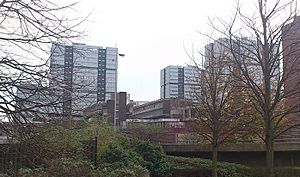
For the first half of the 1900s, Anderston felt like a large village within the city. Even though it was part of Glasgow, it had its own strong local feeling. It had many shops, cinemas, and jobs. Like other parts of Glasgow, families and friends often lived nearby. Everyone knew each other well. But this changed after World War II.
Some buildings in Anderston were destroyed during air raids in May 1941. These were on Finnieston Street, Hill Street, Hydepark Street, and Lancefield Street.
After the Second World War, leaders wanted to fix the bad housing and overcrowding in inner-city areas across Britain. A plan called the Bruce Report in 1945 suggested "Comprehensive Development." This meant tearing down old, poor-quality homes and slums. Then, new, planned communities would be built. Glasgow had 20 such areas, and a large part of Anderston was one of them.
Anderston's housing problems were not worse than other areas. But it was chosen for special attention. This was because Glasgow needed better roads. Plans were made to build a motorway through the city. This motorway would go through Anderston Cross, the heart of the community. The plan to redevelop Anderston was approved in 1961.
The new Anderston would have three main parts:
- A Commercial Zone for offices and businesses. This would be on the eastern edge of the city centre.
- A Residential Zone with new homes, just to the east.
- An Industrial Zone to the southeast.
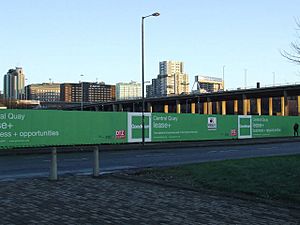
Work on the new roads and tearing down homes happened throughout the 1960s. By the 1970s, the new Anderston looked very different. The crowded homes and streets of tenements were gone. Most residents had moved to new places like Knightswood, Easterhouse, Cumbernauld, Drumchapel, and East Kilbride. In 1951, Anderston had 31,902 people. By 1971, this number dropped to 9,265 because of the changes.
There were two major fires in Anderston in the 1960s. The first was in March 1960 on Cheapside Street. A building storing whisky caught fire and exploded. The explosion happened over an hour after the fire started. It caused part of the building to fall on three fire engines, trapping firefighters. Fourteen firefighters and five salvage workers died. The second fire was in November 1968 in a factory on James Watt Street. Twenty-two workers were trapped because they could not get through the barred windows.
Many tenement buildings in the area were taken down in the 1970s. This made way for the M8 motorway and Kingston Bridge. Anderston Cross was replaced by the Anderston Centre.
Anderston in the 2000s
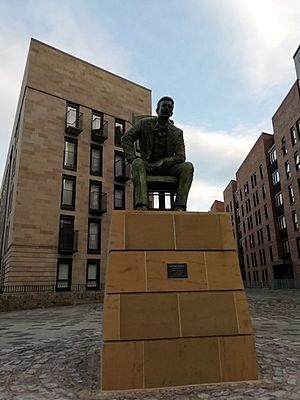
As Glasgow's financial district grew, Anderston started to get better in the 2000s. New, very modern office buildings, international hotels, and new homes have appeared. This has greatly improved how the area looks and its reputation. The three tall buildings of the Anderston Centre were almost torn down. But they were saved and updated instead, after a housing group took them over.
Around 2010, the outside of these buildings was being redone to match new private homes nearby. In 2011, work began to tear down much of the original 1960s housing estate east of the motorway. This included the Shaftesbury tower. The original street plan, including Argyle Street, was also being brought back. This project, by Sanctuary Scotland, won several awards. It also features a statue of Charles Rennie Mackintosh (made by Andy Scott) as its main artwork.
Education
- Anderston Primary School (opened 1973) is a public school on Port Street in Anderston.
- St Patrick's Roman Catholic Primary School (opened 1962) is on Perth Street in Anderston.
Sports Teams
The area has a football team called Anderston Athletic. They play in the Glasgow Colleges FA - Division 2.
Leaders of Anderston (Provosts)
Here is a list of the people who served as Provost of Anderston when it was an independent town:
- Henry Houldsworth 1824–32
- Angus McAlpine 1832–33
- Patrick McNaught 1833–35
- James Turnbull 1835–37
- Henry Houldsworth 1837–39
- James Jarvie 1839–42
- John Miller 1842–43
- John Houldsworth 1843–46
Famous People from Anderston
Many well-known people have connections to Anderston:
- Sir Billy Connolly (born 1942) – a famous comedian, musician, and actor.
- Daniel Cottier (1838–1891) – an artist and designer.
- Arthur Henderson (1863–1935) – a former leader of the Labour Party, who also served as a government minister and won the Nobel Peace Prize.
- Peter Keenan (1928–2000) – a boxing champion from Britain and Europe.
- Johann Lamont (born 1957) – a former leader of the Scottish Labour Party.
- Sir Thomas Lipton (1848-1931) – a successful businessman and yachtsman.
- Roddy McMillan (1923-1979) – an actor and writer for plays.
- Michael Martin, Baron Martin of Springburn (1945–2018) – a former Member of Parliament (MP) and Speaker of the House of Commons.
- Alex Mosson – a former councillor and Lord Provost (leader) of Glasgow.
- Tony Roper (born 1941) – an actor, comedian, and writer.
- Eddi Reader (born 1959) – a singer and songwriter.
See Also


